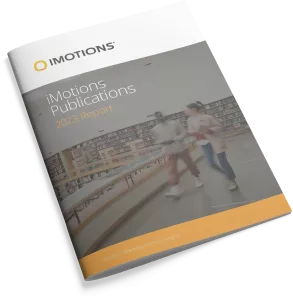-
Emotional expressions associated with therapeutic inertia in multiple sclerosis care
Abstract BackgroundEmotions play a critical role in our daily decisions. However, it remains unclear how and what sort of emotional expressions are associated with therapeutic decisions in multiple sclerosis (MS) care. Our goal was to evaluate the relationship between emotions and affective states (as captured by muscle facial activity and emotional expressions) and TI amongst […]
-
A Critical Analysis of FDA Guidance for User Percentile Device Design Criteria Versus Currently Available Human Factors Engineering Data Sources and Industry Best Practices
Objective To report on the use of an eye-tracking retrospective think-aloud for usability evaluation and to describe its application in assessing the usability of a mobile health app. Materials and Methods We used an eye-tracking retrospective think-aloud to evaluate the usability of a HIV prevention mobile app among 20 young men (15-18 years) in New […]
-
Investigation of the dependency of the drivers’ emotional experience on different road types and driving conditions
Abstract: The growing sophistication of technologies and sociological advances are major causes for the dramatic change the automotive sector is currently undergoing. To address changes from a human-centered design perspective an improved understanding of the occupants’ emotional experience and behavior is required. Facial-Expression Analysis (FEA) is an emerging tool in support of such an approach, […]
-
Eye tracking in cytotechnology education: “visualizing” students becoming experts
This study reports the potential of eye-tracking technology in determining screening skills of cytotechnology (CT) students while examining digital images (DI). Materials and methods Twenty-five static DI of gynecologic cytology specimens were serially displayed on a computer monitor for evaluation by 16 CT students and 3 cytotechnologists at 3 locations. During evaluation, participant’s eye movements […]
-
A Critical Analysis of FDA Guidance for User Percentile Device Design Criteria Versus Currently Available Human Factors Engineering Data Sources and Industry Best Practices
Abstract: A staggering report was recently released by the International Consortium of Investigative Journalists (ICIJ) indicating that 83,000 deaths and 1.7 million injuries were linked to medical device adverse events reported over the last decade (Díaz-Struck, 2018). Furthermore, a 2013 report by McKinsey & Company suggested that such adverse events and associated quality issues cost […]
-
Eye Tracking as a Method of Neuromarketing for Attention Research—An Empirical Analysis Using the Online Appointment Booking Platform from Mercedes-Benz
Abstract: A good user experience can only be achieved by knowing and understanding users’ wishes, needs and cognitive abilities. The aim of this study is to find out how the user of the online appointment booking interacts with the interface as well as the visualizations. The focus is on the question of whether the new […]
-
Investigating the effect of indoor thermal environment on occupants’ mental workload and task performance using electroencephalogram
Abstract: Workers’ performance in indoor offices can be greatly affected by the thermal condition of the environment. However, this effect can be difficult to quantify, especially when the thermal stress is a moderate increase or decrease in temperature and the work productivity cannot be directly measured. Subjects’ high motivation to perform well under experimental conditions […]
-
Mitigating passive fatigue during monotonous drives with thermal stimuli: Insights into the effect of different stimulation durations
Abstract: Driving on monotonous roads has been shown to cause passive fatigue as even non-sleep-deprived drivers suffer from the lack of stimuli. Consequently, alertness is reduced and the risk of accidents increases. To counteract this risk, measures need to be taken to mitigate driver fatigue. While in the past, some studies have been focused on […]
-
Role of Effective Communication in Trust Building: Application to Human-Computer Interaction
Prior work notes dispositional, learned, and situational aspects of trust in automation. However, no work has investigated the relative role of these factors in initial trust of an automated system. Moreover, trust in automation researchers often consider trust unidimensionally, whereas ability, integrity, and benevolence perceptions (i.e., trusting beliefs) may provide a more thorough understanding of […]
-
Adding immersive virtual reality to a science lab simulation causes more presence but less learning
Abstract: Virtual reality (VR) is predicted to create a paradigm shift in education and training, but there is little empirical evidence of its educational value. The main objectives of this study were to determine the consequences of adding immersive VR to virtual learning simulations, and to investigate whether the principles of multimedia learning generalize to […]
Research Report 2023
In-depth look at the scientific landscape as powered by iMotions software, showcasing groundbreaking research and the impact of our tools in various scientific and industrial fields.

Share Your Research

850+ universities worldwide with an iMotions human behavior lab
73 of the top 100 highest ranked universities
710+ published research papers using iMotions
iMotions is used for some of the most interesting human behavior research studies carried out by top researchers around the world. Contact us to have your publication featured here.
The authors of these publications have used iMotions as a software tool within their research.
“Software should be cited on the same basis as any other research product such as a paper or a book; that is, authors should cite the appropriate set of software products just as they cite the appropriate set of papers” (Katz et al., 2020).
We therefore encourage you to cite the use of iMotions where appropriate.
How to cite iMotions
APA
iMotions (10), iMotions A/S, Copenhagen, Denmark, (2024).
Note: adjust the version and year where relevant.
5 Most Popular Blogs
Learn How to Conduct Human Behavior Research with iMotions
Publications
Read publications made possible with iMotions
Blog
Get inspired and learn more from our expert content writers
Newsletter
A monthly close up of latest product and research news





